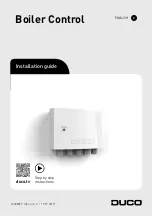
Mighty Max Hydronic Boiler
Page 23
inner surface of the heat exchanger tubes and
restrict the water flow. Inspect the heat exchanger in
accordance with Section 4B-1.
If the heat exchanger needs cleaning, see
Section 4B-2.
4B-1. Inspection of the Heat Exchanger
WARNING
Improper installation or maintenance can
cause nausea or asphyxiation from carbon
monoxide in flue gases which could result in
severe injury, property damage, or death.
4B-1a. External Heat Exchanger
Inspection
1.
Disconnect electrical supply to the heater.
2.
Turn off the gas supply by closing the manual
gas valve on the heater.
3.
On indoor models, remove the vent pipe, top
jacket section, flue collector.
4.
On outdoor models, remove outdoor vent
terminal, top jacket section, flue collector.
5.
After removing the flue collector, inspect the
finned copper tubing using a flashlight.
6.
If there is a buildup of black carbon soot or other
debris on the heat exchanger tubes which may
restrict flue gas passage, refer to Section 4B-2a.
7.
If there is no buildup of black carbon soot or other
debris which may restrict flue gas passage
through the heat exchanger, reassemble the heater.
4B-1b. Internal Heat Exchanger Inspection
1.
Remove the inlet/outlet header of the heat
exchanger.
2.
Remove the return cover of the heat exchanger.
3.
Inspect the internal surface of the copper tubes
for signs of scale buildup and erosion.
4.
If build-up exists, clean per 4B-2b.
4B-2. Cleaning the Heat Exchanger
4B-2a. Cleaning the Heat Exchanger -
External
NOTE: The heat exchangers are heavy and may
require two people to remove to avoid personal injury.
Caution
Black carbon soot buildup on a dirty heat
exchanger can be ignited by a random spark or
flame. To prevent this from happening,
dampen the soot deposits with a wet brush or
fine water spray before servicing the heat
exchanger.
1.
Disconnect the 120 Vac electrical supply to the
heater.
2.
Turn off the gas supply by closing the manual
gas valve on the heater.
3.
Disconnect and remove the wires and conduit
from the low water cutoff.
4.
Remove the top jacket section, venting and the
flue collector as mentioned in Section 4B-1
“Inspection of the Heat Exchanger”.
5.
Isolate the heat exchanger from water supply.
6.
Drain the heat exchanger.
7.
Disconnect the flange and adapter tee from the
heat exchanger inlet and outlet.
8.
Remove temperature sensing probes from the
inlet/outlet header.
9.
Remove the heat exchanger from the heater.
10.
Remove the heat baffles from the heat
exchanger.
11.
Clean the heat exchanger: A light accumulation
of soot or corrosion on the outside of the heat
exchanger can be easily removed after the heat
baffles are removed. Use a wire brush to remove
loose soot and scale from the heat exchanger. Do
not use water or compressed air for cleaning.
NOTE: While the heat exchanger is out of the
heater, inspect the firewall refractory insulation
blocks for cracks, wear and breakage. Replace if
necessary.
4B-2b. Cleaning the Heat Exchanger -
Internal
1.
Remove the inlet/outlet header of the heat
exchanger.
2.
Remove the return cover of the heat exchanger.
3.
Clean the internal surface. (Laars offers a tube
cleaning kit part no. R00100000.)
4.
Reassemble in the reverse order.
4C. Gas and Electric Controls
The gas and electric controls on the heaters are
designed for both dependable operation and long life.
Safe operation of the heater depends on their proper
functioning. A professional service technician should
check the following basic items every year, and
replace when necessary.
NOTE: the warranty does not cover damage
caused by lack of required maintenance or improper
operating practices.
1.
Water temperature controls.
2.
Ignition control system.
3.
Automatic electric gas valve(s).
4.
Flow sensing safety device (when used).
5.
Low water cutoffs, including flushing or float
types. (Every six months)










































